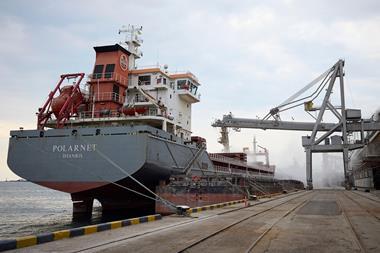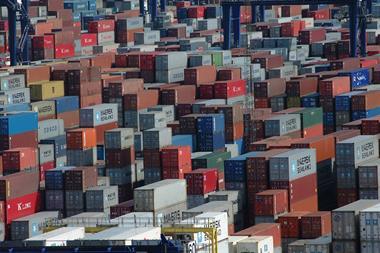
Twenty-one grain shipments have now left Ukraine’s besieged ports under a deal agreed last month to grant passage for food and fertiliser through the Black Sea, according to an official report published this week.
The Black Sea Initiative Joint Coordination Centre, an oversight body made up of Russian, Turkish, Ukrainian and United Nations officials, said more than half a million tonnes of grain had been sent to destinations including China, Iran, Ireland, Italy, South Korea, Turkey and the UK.
Shipments so far include 13,000 tonnes of corn on 5 August from the port of Chornomorsk to Teesport on the North Sea coast of Yorkshire – a small fraction of the roughtly 450,000 tonnes of corn that had been exported under the deal, which was agreed despite the ongoing Russia-Ukraine war.
The rest of the grains dispatched since the deal was struck came to around 110,000 tonnes and were made up of wheat, sunflower oil, sunflower seeds, sunflower meal and soya beans, according to the JCC.
The first ship carrying grains under the deal set sail on 3 August, with a consignment of 26,000 tonnes bound for Lebanon – which has seen food price inflation of over 100% this year. One of the subsequent shipments was aimed at addressing possible drought-related food shortages in Ethiopia via a World Food Programme distribution centre in Djibouti, the JCC report said.
Ukraine was before the war the world’s biggest source of sunflower oil and one of the biggest exporters of corn and wheat. Russia, which has been accused of selling Ukrainian grain to allies in the Middle East, was the world’s biggest exporter of wheat prior to its invasion of Ukraine – a position it looked set to retain this year despite the war and economic sanctions imposed by western governments.
An estimated 20-22 million tonnes of grains, mostly from pre-war harvests, had been stockpiled at Ukrainian ports as exports slowed due to the war, with west-bound rail links able to take around one-seventh the amount usually sent by sea.
Rabobank grains analyst Michael Magdovitz said though he was “cautiously optimistic about the shipments”, getting more of Ukraine’s grain to sea “really need[s] private vessels to come in en masse”.
Disagreements had earlier surfaced over the terms of the deal – which is in fact two separate agreements: one involving Ukraine, Turkey and the UN, with the other between Russia, Turkey and the UN – over how inspections would work in the middle of a war.
What can the Ukraine grain export deal achieve after missile strike?
The ports have been under siege from Russia’s Black Sea navy since the late February invasion of its neighbour. Ukraine mined the ports in response, a defensive measure that means, under the deal, its navy must guide commercial ships ferrying grains from the ports, all within range of the Russian warships.
“Many players are super-cautious,” said Masha Belikova of commodity price reporting agency Fastmarkets.
The JCC said this week that officials had from 15 August conducted 27 inspections of ships heading in to and out of the ports, though 36 such “vessel movements” had been authorised over the two weeks since the deal was implemented.
The JCC added it was “closely monitoring the inbound and outbound movement of vessels through the maritime humanitarian corridor in the Black Sea” and had “so far observed on two occasions vessels deviating from the corridor”. It said it then “responded appropriately by contacting captains and advising them to follow the co-ordinates”.
The day after the deal was agreed in Istanbul, Russian rockets struck Odesa, one of three Ukrainian ports from which exports are being facilitated, adding to concerns the agreement, which the UN talked up as a “landmark” aimed at preventing famine and reducing food commodity prices, would be dead on arrival.
Tthe UN Food and Agriculture Organization’s global agri-commodity price index for July showed world wheat prices down in some cases by “as much as 14.5%”, which it said was “partly in reaction to the agreement” and “partly to seasonal availability from ongoing harvests in the northern hemisphere”.
But in its latest food commodity prices update, published the same day as the FAO’s July index, IHS Markit said “wheat prices are expected to stay at high levels and volatile as uncertainty resulting from the war in Ukraine lingers”.
Surging food commodity prices since last year have this year fed into rampant consumer price inflation, including that of food, across almost all major economies. UK inflation topped 10% last month, according to official data published on Wednesday, with food price inflation 2.5% higher again.



















No comments yet